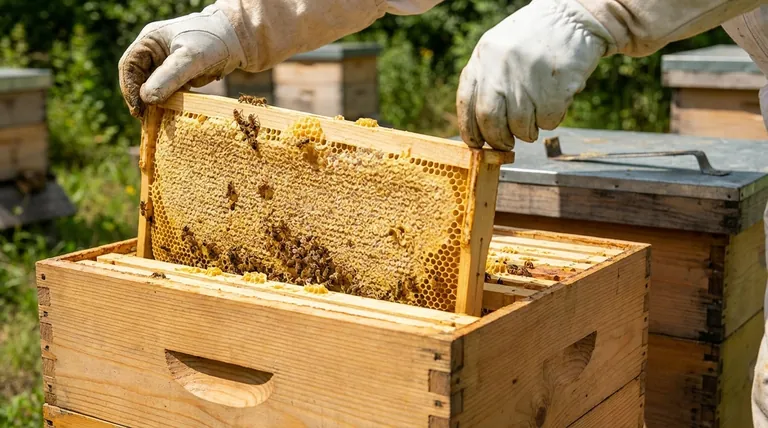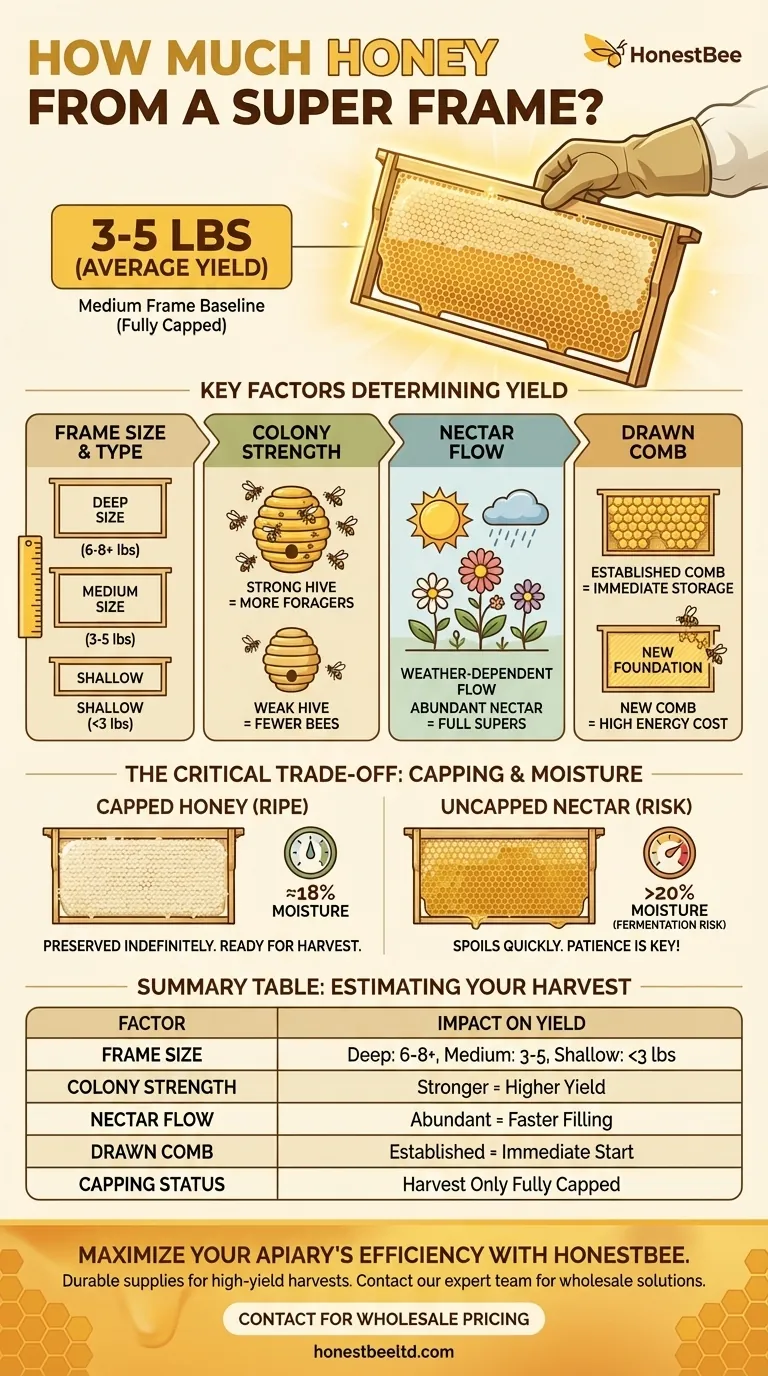A single honey super frame will typically yield between 3 to 5 pounds of extracted honey once it is fully filled and capped by the bees. This figure serves as a useful baseline, but your actual harvest will vary based on several critical factors, including the size of your equipment, the health of your colony, and the environmental conditions of the season.
While a single frame provides a helpful estimate, your total honey harvest is not a fixed number. It is a direct result of the interplay between your hive's population, the availability of local nectar, and your specific management choices.

The Factors That Determine Honey Yield
The 3-to-5-pound range is an average. To truly understand and forecast your potential harvest, you must look at the key variables that influence honey production.
Frame and Super Size: The Physical Container
Not all frames are created equal. The most common sizes used for honey supers are medium (6-5/8") and shallow (5-7/8"). Deep frames (9-5/8") hold the most honey but are significantly heavier and often reserved for the brood chamber.
A fully capped medium frame is the industry standard for the 3-5 pound estimate. A shallow frame will be slightly less, while a deep frame could yield 6-8 pounds or more.
Colony Strength: The Workforce
A strong, populous colony with a large force of forager bees is an efficient honey-producing machine. A weaker hive, or one recovering from disease or swarming, will have fewer bees available to collect nectar.
Therefore, a key part of maximizing honey yield is good apiary management that fosters robust colony health and population growth ahead of the main nectar flow.
Nectar Flow: The Raw Material
Honey production is entirely dependent on the nectar flow, which is the period when local plants are producing abundant nectar. This is influenced by weather, rainfall, and season.
A year with a strong, prolonged nectar flow will allow bees to fill boxes quickly. Conversely, a drought, late frost, or periods of cold, rainy weather can stop a nectar flow in its tracks, drastically reducing the potential harvest.
Drawn Comb: The Foundation of Production
Bees use a significant amount of energy—and consume a lot of nectar—to build wax comb on new foundation. A hive that already has "drawn out" comb from previous seasons can immediately begin filling it with nectar.
First-year beekeepers should expect a much smaller harvest, as the colony will dedicate most of its resources to building out the wax comb it needs for brood and future food storage.
Understanding the Trade-offs
Simply having nectar in a frame is not the same as having harvestable honey. Misunderstanding this distinction is a common and costly mistake for new beekeepers.
The Importance of "Capping"
Capped honey is honey that the bees have dehydrated to the correct moisture content (around 18%) and sealed with a layer of fresh beeswax. This process ripens the honey and preserves it indefinitely.
Only fully or mostly capped frames should be harvested.
The Risk of Harvesting Uncapped Honey
Harvesting frames with a large amount of uncapped nectar is a significant error. This "green" honey has a high moisture content and will ferment and spoil quickly after extraction.
Patience is critical. It is always better to wait for the bees to cap the frames properly than to rush a harvest and risk losing the entire batch.
Partial Frames and Realistic Expectations
Bees do not always fill frames evenly. It is common to find frames that are 80-90% capped, which are perfectly acceptable for harvest.
However, you must adjust your expectations. A super full of partially filled or partially capped frames will yield significantly less honey than one where every frame is packed and sealed wall-to-wall.
Estimating Your Total Harvest
Moving from a per-frame estimate to a total harvest requires combining these factors into a practical forecast for your apiary.
- If your primary focus is a successful first year: Concentrate on building colony strength and getting comb drawn out. Consider any honey harvested a bonus, not an expectation.
- If your primary focus is maximizing yield from an established hive: Use the 3-5 pound estimate for each fully capped medium frame you see during an inspection to get a rough total, but be prepared to adjust based on how many frames are truly ready.
- If your primary focus is diagnosing a low yield: Analyze the key variables—a poor nectar flow (bad weather), a weak or sick colony, or the need to draw new comb are the most common culprits.
Understanding these variables transforms you from a simple honey collector into a strategic and more successful beekeeper.
Summary Table:
| Factor | Impact on Honey Yield |
|---|---|
| Frame Size | Deep: 6-8+ lbs, Medium: 3-5 lbs, Shallow: <3 lbs |
| Colony Strength | Strong hive = more foragers = higher yield |
| Nectar Flow | Abundant nectar from good weather = full supers |
| Drawn Comb | Established comb allows immediate nectar storage |
| Capping Status | Only harvest fully/mostly capped frames to prevent spoilage |
Ready to maximize your apiary's honey production and efficiency?
As a commercial beekeeper or distributor, your success depends on reliable, high-quality equipment. HONESTBEE supplies the durable beekeeping supplies and wholesale equipment that robust colonies and high-yield harvests are built upon.
Let's discuss how our products can support your operation's growth and profitability.
Contact our expert team today for wholesale pricing and tailored solutions!
Visual Guide

Related Products
- Assembled Wooden Bee Frames with Beeswax Foundation Ready to Use by HONESTBEE
- Heart-Shaped Comb Honey Frame and Honeycomb Cassette
- HONESTBEE Bee Frame Grooving Machine | Precision Slotting for Bee Frame Making
- Professional 500g Sectional Comb Honey Frame System for Beekeeping
- Plastic Bee Frame Beekeeping Hive Frames for Wholesale
People Also Ask
- How many frames fit in a 10 frame hive? A Guide to Maximizing Your Hive's Potential
- Can old bee frames be reused? Weighing the Risks vs. Rewards for Your Hive
- What are the advantages of using wooden beehive frames? Natural, Sustainable, and Bee-Friendly
- What are some tips for setting up hive frames? Build a Strong Foundation for Your Hive
- How are Langstroth beehive frames assembled? A Step-by-Step Guide for a Durable Hive



















